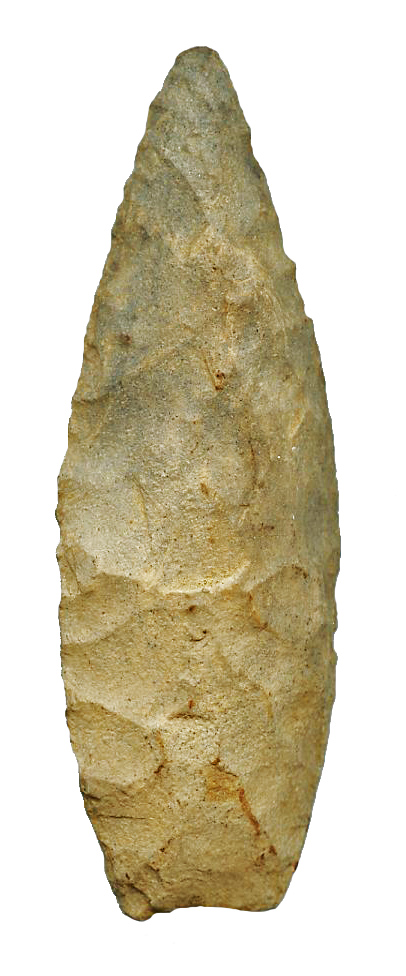

Point Type: GUILFORD-YUMA a.k.a Guilford Concave
Base
Also See: Clovis Unfluted, Guilford
Lanceolate,
Yadkin
Eared
Location: Eastern United States
Associated Dates:
7000 - 5000 B.P. - Early Archaic
Morphology: Lanceolate
General Description: The Guilford-Yuma
point type is also known as the Guilford Concave Base which is a sub-type
of the larger Guilford Lanceolate Point type family. The Guilford-Yuma is
a medium, slender, but thick lanceolate bladed point with a concave
base. The blade
edges are straight or excurvate.
The Guilford-Yuma type is usually crudely chipped and their
cross-section is more
rounded than elliptical and in some cases can be diamond shaped. Both
blade edges sometimes show grinding about one third of the lower blade. Other than
the possible edge grinding, there is no real distinction between the blade area
and the stem or hafting area.
The Guilford-Yuma is believed to be an early form of
the Guilford Lanceolate family and may be related to the Conerly point
type.
The
point can be found in North Carolina, South Carolina, Virginia and parts of adjacent
states.
The Guilford-Yuma point is
typically made from quartz, quartzite, rhyolite and silicious slate.
The quality of the flaking is governed by the
type of material. They were made with random
percussion
with very little pressure retouch. Many examples have been flaked with
only hammerstone blows, however this crudeness may be a result of poor quality
materials being used in their manufacture. Flaking can be large and
diagonal to random.
The Guilford Lanceolate point type
was named by Joffre Lanning Coe in 1964 for examples found
in Guilford County, North Carolina.
About the Point Above: The Guilford-Yuma point pictured at the top of this page, was found in North Carolina and I consider it a perfect example of the type. The point is made from light tan and gray (especially near the tip) grainy chert or shale. The point was made with random percussion but there is edge flaking especially from the middle of the blade foreward. The cross section in very much rounded neat the tip and then becoming flatter to an eliptical shape in the halfting area. Overall, the point measures 74 mm in length, is 26 mm wide across at the top of the hafting area and is 12 mm thick in mid blade just above hafting area. The base is 14 mm wide and the hafting area, which is ground to about 30mm from the base . Catalog Number 191-29-C
References: Dragoo (e), Hranicky, Overstreet, Painter, Peck, Perino (1), Waldorf
© Copyright 1997 - 2008 LITHICS-Net WWW.LITHICSNET.COM
Use your Browser's BACK Button to return to the LITHICS-Net Index.